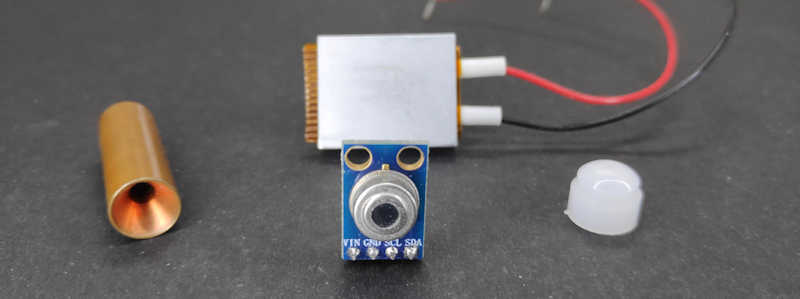MLX90614 With Heating Plate

Disclosure: Some of the links below are affiliate links and we only earn a small commission if you purchase through our links at no additional cost to you. The earning mainly used for maintaining the website.
Most of my MLX90614 are tested with hand temperature. As the distance to spot ratio calculated in the previous blog is quite relevant, this time I will be using a high-temperature object to do the testing.
In this blog, I will be using a heating plate to test for the distance to spot ratio of MLX90614 without lenses, with a copper lens hood and Fresnel Lens.
Starter Pack
- Arduino Uno/Mega/Nano
- MLX90614 Contactless Infrared Temperature Sensor
- Copper Lens Hood
- Fresnel Lens
- 12V Heating Plate
- Breadboard
- Jumper Wires
- Hookup Wires
The Setup
All components are arranged perpendicularly to each other so that the heating plate is filled in the FOV of the MLX90614. It must be located at the center of the heating plate vertically and horizontally. This is to make sure that the MLX90614 receives radiation only from the heating plate rather than unwanted radiation.
Because I can not find any larger heating plate, for each step, I will move the heating plate away from the sensor by roughly 0.2 to 0.3cm with a starting point of 0.25cm to 2cm distance.

Heating Plate Size
The heating plate I have with me, size 2 by 4cm. To make sure the sensor spot area is within the plate, the height to be considered into distance to spot ratio calculation is 1.5cm. So we can surely confirm that the area read by MLX90614 is still within the heating plate.
Distance to Spot Ratio of MLX90614
The distance to spot ratio calculate is 0.75:1.5 in cm. By theory, the temperature readings should not drop within 0.75 cm away from the sensor.
Distance to Spot Ratio of Copper Lens Hood
For copper lens hood, the calculated D:S is 1.3:1.5 in cm. Distance longer than 1.3 cm should show temperature drops for and object of height 1.5 cm.
Distance to Spot Ratio of Fresnel Lens
Well, the FOV (field of view) of the Fresnel Lens is a little bit complicated. Unlike copper lens hood, vertically and horizontally evenly 60 degrees. Imagine a perfect circle spot. So, the Fresnel Lens is an oval spot. Vertical FOV is 20 degrees while horizontal FOV is 30 degrees.
So I will take 30 degrees into the calculation as it is the smallest distance can go and still fall within the plate. If 20 degrees is taken into calculation, there is a chance the horizontal FOV is outside of the heating plate area.
The Results
The actual temperature of the heating plate is not so important because when the lenses are installed on the sensor, the temperature readings will be lower as compared to the readings without using the lens. As long as the stable temperature readings are achieved, that’s the maximum temperature can be read by the sensor without or with the lenses.
As can see from the temperature graph, the distance to spot ratio calculated earlier is not applicable. Even a very small distance moved the temperature drops. The distance moved definitely is within their respective distance to spot ratio.
Nay! We Love Videos
Bye Bye
Without or with the lenses, the behavior of the temperature drop is the same at high temperatures. But, at least, when tested with hand temperature like my previous testing, the temperature readings do follow the distance to spot ratio. Leave your comments below on how you think of this testing.
Hope you find this tutorial helpful in your projects. Subscribe to our newsletter for more tutorials.









